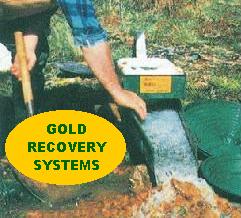
| March 1999 | ||||||||||||||||||||||||||||||||||||||||||||||
|
||||||||||||||||||||||||||||||||||||||||||||||
Contents
|
||||||||||||||||||||||||||||||||||||||||||||||
| 1. EDITORIAL Over the past two months there have been some exceptional nuggets found. We continue to hear of large nuggets being unearthed from sites that have been well worked. Well worked by the original diggers more than a century ago, and more recently by those privateers with their new technically advanced detectors.
With the advent of metal detectors in Australia it is estimated that over $A100,000,000 in gold has to date been recovered using this new technology.
As technological advances are made, the earth will undoubtedly surrender more and more gold. This last month alone there were 30 oz and 20 oz nuggets taken from the golden triangle in Victoria, and a rather nice 78 oz nugget taken from the gold fields in the Pilbara, Western Australia, and a 28 oz nugget from near Leonora, W.A. More and more overseas enthusiasts are visiting this wonderful country and trying their luck. We hear that many are being rewarded with fine nuggets. We welcome visitors from overseas and wish you luck with your endeavours. This news whets ones appetite, and I intend to head back to the Victorian gold fields next week to try my luck for that illusive yellow metal, in a nice secluded location I "discovered" on my last trip. No doubt, many others seeking their little patch of gold will join me. I look forward to seeing you "out there". Editor Email: [email protected] All material in this magazine is copyright and may not be reproduced in any part or form whatsoever without written permission from the publisher.
|
||||||||||||||||||||||||||||||||||||||||||||||
|
2. THE CANTON LEAD by Jim Foster I n late May, 1857, a party of illegal Chinese miner immigrants were making their way overland from Robe in South Australia to the Victorian goldfields. While resting at Ararat in Victoria they discovered the fabulous Canton Lead. This find was to mark the beginning of the rich Ararat goldfield, which grew from empty wilderness to a population of more than 30,000 in a few short weeks. Being three miles in length, the lead was to become the richest shallow alluvial goldfield in the world. In the first three months it yielded three tons of gold and some ten tons of gold over the next ten months. The Chinese, however, broke an un-written law of the goldfields in not flying a red flag to disclose the discovery of a new find. European miners retaliated by burning their tents and chasing them from the ground. Then the great rush began. Seven thousand diggers were on the Canton by the first week in June and hundreds more were on their way from the diggings at Dunolly, Maryborough, Avoca and other fields. Some walked carrying their swags, some pushed handcarts, and the lucky ones rode. Coaches packed with eager passengers jolted and swayed over the rough tracks leading to the new eldorado. The Canton Lead was traced for nearly three miles. At one end it was 30 chains wide (1 chain = 21 metres). Gold bearing gravels were found on Surface Hill and the White Patch southeast of the Canton. Soon the roar of hundreds of gold cradles rocking the gold through, filled the Ararat valley as the diggers found the Wet Leads which branch from Mullock Bank and the Old Deep Lead at Bridal Hill and extended to Caledonian Lead north of the town. "In one instance," wrote the resident Gold Warden "eleven pounds troy of gold was washed from three loads of stuff from the wet lead." In four hectic weeks the population soared to 20,000. The Crescent City, Foo's Golden Age, The Ancient Briton, Noah's Ark, and a dozen other hotel bowling alleys and saloons took their share of the diggers' gold. There was said to be 500 sly grog shanties on the field at one time. Beef and mutton prices rose to eight pence a pound and before the autumn rains came, water cost up to sixpence a bucket. Although the Chinese had been chased from the field at the beginning, not all of them missed out. Many fortunes were made and shipped back to villages throughout Kwangtung Province and its capital, Canton. The Chinese, having been responsible for the discovery of the Canton Lead, continued to play a major role in the development of the city of Ararat. It was to promote the public awareness of the role played by the Chinese in the discovery of gold and the settlement of Ararat that the Ararat Chinese Heritage Society was formed. The first project by the society was to commission local sculptress Dorothy Saaghy to create a life-size statue of a Chinese miner depicting the discovery of the Canton Lead. This statue can be seen in the temporary offices of the society on the Adelaide road on the northern edge of town. The society is preparing a site, including the original mine for the new Chinese Gum San museum just across the road.
Visitors to the city are well catered for with many hotels, motels, and bed and breakfast establishments in and around the city. Two caravan parks cater for caravaners and campers. The surrounding bush contains many campsites for those who prefer to rough it. For the detector operator there is plenty of scope despite the Canton Lead being now beneath the city. Locations such as Petticoat Gully, Garden Gully, Opossum Gully, Bridal Hill, Nil Desperandum lead and California Gully all offer the opportunity to search out and uncover nuggets missed by the old-timers. Ararat is located on the Western Highway 200 kilometres (120 miles) from Melbourne, Australia, on the western edge of the world famous Golden Triangle not far from where the giant Hand Of Faith nugget was unearthed by a metal detector operator in the early 1980's.
by John Morris Today, driving into Bendigo, we see housing and large shopping centres like Lansell Plaza, but for the early diggers it was more scrub (Ed: bush) and a narrow track winding up to Eaglehawk and the site of the first gold discovered at Bendigo. A shepherd named Kenneky was working on the Ravenswood sheep run in those early days and had brought his wife Margaret to live there in a bush hut. One day, so the story goes, she was washing his clothes down by a small chain of water holes over by a ramshackle hut occupied by a man who was given the nickname "Bendigo" after a famous heavyweight boxer of the period. While washing clothes, Margaret discovered Gold and the rest was history and of course when giving directions to the new gold field it was always "Over near Bendigo's". Bendigo produced 55% of all the gold mined in Victoria, mainly out of deep quartz mines, but the early alluvial finds were incredibly rich. In fact men laid on the ground at Eaglehawk with a pistol in one hand and a knife in the other to claim the ground that their body could cover and they could defend. The dirt was so rich that they just carted it away in bags without washing it. One claim at Eaglehawk gave 1 1/2 ton of gold from an area 8 feet square and 4 feet deep. As we drive through the main street of Bendigo, we can see what gold has done for this city. The opulent architecture of the public buildings. The Post Office, the Town Hall, the Court Houses, the magnificent fountain in the town centre and directly opposite, the famous "Shamrock Hotel", dating back to 1852. The "Shamrock" is full of history, so original that it was used in an episode of the television series, "The Man From Snowy River". Beautifully restored and featuring stained glass windows, lovely lace ironwork, marble staircases and magnificent original plaster and timber throughout, it is open for business, as it was in 1852 and in fact you can still see the very room where in 1896, the Australian Natives Association voted to allow a referendum on Federation. If this were in the U.S.A, it would be a museum. For in a real sense in this room was the cradle where our nation was formed into Australia. The times and the circumstances of those early days created giants among men in Bendigo, The Beehive building just up from the Shamrock was the Stock exchange and it is still standing today.
There were 5000 mines in the city of Bendigo and a lot of them were owned or controlled by a man called George Lansell. He could be the subject of a whole series on his own and it would make a fictitious "Dallas" of T.V fame look pale by comparison. Today, in and around Bendigo, modern electronic prospectors are continuing the early traditions with the advantage of modern metal detectors. We read regularly of a recent large gold nugget being found by some lucky fossicker, but this is only the tip of the iceberg as over 100 million dollars worth of gold is recorded as having been found in 1995/1996 in Australia by people operating hand held detectors. "Are you getting your share"? You cannot win the lottery if you haven't bought a ticket. Likewise you can't find gold if you don't go looking for it. The Victorian Golden Triangle was and still is the greatest source of gold nuggets that the world has ever seen. Tourists from all over the world are coming here to try their luck. Wish you luck with your quest.
by Catherine Knight Much has been written about the fabulous Golden Mile that has provided so much wealth for Western Australia for over 100 years. During this century like gold fields around the world, there have been periods of great prosperity and at the other end of the spectrum, periods of great hardship. It is doubtful that any other area in the world could have provided so much golden wealth for so long, from such a relatively small area. The story of Kalgoorlie - Boulder, in Western Australia from its origins in the late 1800's to the present day provides a plethora of intriguing stories that provide a grand insight into this intriguing area. From the time Paddy Hannan stumbled onto this area and found gold, starting the great saga of this Eldorado, until the present day, the Kalgoorlie - Boulder area has produced a wealth beyond the wildest dreams of most men. In 1893 the Australian economy had practically collapsed, and it was a God sent gift that just one month after this crash gold was found at Kalgoorlie. With the State government struggling with the burgeoning colony the public infrastructure in the gold fields was to say the least primitive. The most pressing problem was the scarcity of water. Being 300 miles inland and at the western end of the great Nullarbor Plain in relatively flat country, water had to be carried by horse and cart for great distances. Eventually the ingenuity of the diggers mostly overcame this problem, as the mines reached depth water seeped into the lower shafts, and although of poor quality, this precious commodity was desalinated and sold for quite a profit. In fact some mines made more from the sale of water than they did from the sale of gold.
Great Boulder started with a paid up capital of 30,000 pounds. In the first year of operations returns to shareholders exceeded 100,000 pounds. In the second year 200,000 pounds, and in the third 300,000 pounds. A handsome return in anyone's language. In 1898 the Lake View Console Mine averaged 10 oz to the ton. During those early years great wealth was wrought from this Golden Mile. By the turn of the century the population had grown to 25,000. With so many people and so much wealth came the prosperity that flows from such riches. With a rail line established the early years of deprivation and hardship were replaced with an opulence reflected in the buildings and infrastructure that quickly ranked Kalgoorlie as one of the largest cities in Australia at the time. By 1905, Kalgoorlie - Boulder had 6 banks, 3 breweries, 26 hotels, 5 hospitals, and hundreds of shops. There were also as many as three daily newspapers. As this was a male dominated enclave a flourishing red light district was operating with French and Japanese prostitutes. Incredibly, even today Kalgoorlie has a flourishing red light district, famous throughout the world that has continued its unbroken tradition for over 100 years. The local stock exchange was a vibrant facility with as many as 1,000 men bidding at times for shares of quality. Both Boulder and Kalgoorlie had racecourses, and a great deal of rivalry existed throughout the area. By 1903 the government had built a pipeline from the coast to Kalgoorlie and the water shortage was over. With the average rainfall in this area being less than 10 inches a year this event was celebrated with great gusto. That euphoria was short lived as the cost of supplying water was expensive and the government passed those costs on to the consumer. By 1906 there were in excess of 350 stampers working, crushing the ore that was yielding so much wealth. These were the halcyon days that were enjoyed by all. What lay ahead was the economic reality that gold recovery in such quantities could not be sustained for much longer. Mines were already at depth and the frequency of new finds was diminishing. 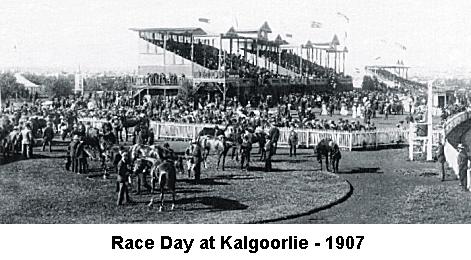 From 1910 onwards the diminishing wealth of the area was well recognised and a number of mining companies consolidated their positions and amalgamated. As the recoveries per ton of ore diminished so did the jobs, and with the advent of the Great War a number of diggers left to enlist and fight on foreign shores. At the conclusion of the Great War, prosperity slowly returned to the Golden Mile. A revolution was occurring in financial circles, with the free market applying to the US dollar and gold prices rose throughout the world. In 1920 returns were exceptional for gold, but this was short lived. Diminishing gold reserves were of concern and by 1922 miners were being laid off in ever increasing numbers. The costs of production were rising while at the same time the ore was becoming less productive. Despite agreement between mining unions and management, it was clear that the Golden Mile has seen its best days. With the world depression of 1929 came hard times for Kalgoorlie, and it was not until 1931, when the Australian Government was forced to devalue the Australian Pound by almost 25% that gold being sold on the world market returned profitability. Great wealth had at last returned to the golden mile. Throughout the thirties with the advent of technology, required labour was diminishing, and with it came a blot on Kalgoorlie's history. The presence of foreign labour was always a contentious issue that in 1934 boiled over into mob violence following the death of a popular footballer who died following a fist fight with an Italian born barman. Several hundred men took the law into their own hands and rioted, smashing selected shops and selecting foreigners for beatings. Most fled or hid in the scrub, until the ruckus had died down. The mines were closed for a week, and eventually it was agreed that if English was spoken by the foreigner, he could maintain his employment.
1973 left only two major mining companies. The boom in nickel was overtaking gold as the sought after commodity and the two remaining gold mining companies amalgamated. From this time gold had been mined but is now essentially a by-product of combination mining. Nickel, being the dominant metal now sought, with gold being a prominent by product. Prominent indeed, as mining is again booming in the area surrounding Kalgoorlie. Some of these facilities are employing up to 1,500 personnel and the wealth from these mines with their improved technologies is creating great demand for housing and other infrastructure. Gold mines are again being opened up and great wealth is being extracted once again. Kalgoorlie provides much of the infrastructure and support for these new facilities. The wealth of the Golden Mile continues.
|
||||||||||||||||||||||||||||||||||||||||||||||
|
||||||||||||||||||||||||||||||||||||||||||||||
|
||||||||||||||||||||||||||||||||||||||||||||||
|
||||||||||||||||||||||||||||||||||||||||||||||
|
5. LODES AT MARYBOROUGH Bill "Nugget"Jones Maryborough is a delightful town nestled in the Pyrenees about 50 miles north east of Ballarat. The main street today follows the same route laid out in 1854 when the area was rushed with the discovery of gold. The ground surrounding Maryborough had yielded gold before 1854, but not in the quantities now evident. The first big rush commenced in June 1854, at Four Mile Flat and as word reached other areas the rush turned into a tidal wave of diggers moving into the area. In just one month the population swelled from 150 to over 1000, and two months later that number has swelled to an estimated 7,000. In another two weeks the human tide had reached 20,000 plus souls. By the middle of September the number had reached 27,000, and with that number came the usual storekeepers, brothels, sly grog shops (illegal liquor) and hotels, who set up tents along the road, at times the proprietors fighting for the most advantageous locations. By the end of 1954, the population was estimated at close to 60,000. Gold was literally oozing from the ground from new finds in the area. Most gold was found within a radius of about 10 miles from Maryborough itself. One of the gold bearing areas was called Waterloo, after a reputed battle between the Irish and the English miners, was fought a bare-knuckle engagement there. There was no doubt who won the day. Another pitched battle occurred between Chinese factions just south of Maryborough in August 1855. It was indeed a frontier town. With such a rapid increase in population came a surge in lawlessness that was soon in epidemic proportions. Initially there were only two constables allocated to the Maryborough district and bushrangers, vagabonds, thieves and rogues were drawn to the easy pickings. Crime was rife with holdups, murders, violent robberies and shootings common place. Diggers formed themselves into vigilante groups to provide some protection for their hard earned gains. From this area came a minimum of 8,000 oz. of gold a week that was taken under escort to Melbourne. Even under escort bushrangers successfully held up and took the booty on more than one occasion. The sheer volume of gold that the ground gave up was staggering, and stories of good and bad luck abound. One disgruntled digger walking away from the gold fields found a 73 oz. nugget on the side of the road. A digger abandoned his claim only to have another take over 430 oz. from it in total, with nuggets up to 63 oz. Two Prussians unearthed a nugget weighing 492 ounces, at a depth of 7 feet in August 1854. The main lead extended for over 8 miles, with a large portion of the recoverable gold near the surface. It was easy pickings for experienced diggers, many of whom had come from Ballarat , Bendigo, and from Avoca. Gold was so plentiful that even doctor's, lawyers and the like shed their suits and joined the diggers. A group of Americans washed 80 oz. of gold from one bucket of dirt, and many small claims produced over 800 oz. of gold. One claim recovered on average 16 oz. of gold per shovel full of dirt at its base. Maryborough's gold commissioner was James Daly, who was an experienced administrator, and his cool head and fair decisions were recognized and accepted throughout the area. It is recorded that he was often cheered as he made his way around the gold fields. Coach services were established only two months after the rush with the famous Cobb and Co. coach line opening a run in December 1854 from Maryborough to Castlemaine and on to Melbourne. Following the Eureka Stockade slaughter in December 1854 the diggers refused to pay the license fee of one pound per month, and Maryborough was no exception. When a number of men were arrested and interned for non payment of license fees, a large group of local diggers simply overpowered the outnumbered constabulary and released them. James Daly with his cool head let the matter lie. It appears that the town of Maryborough was central to most of the rushes, with diggers upping stakes and moving from one rush to the next as they occurred, at times on a weekly basis. One old timer described these movements as "A shifting sea of humanity". The stability required to establish permanent buildings was not evident until early in 1855, when brick and timber buildings began to be erected along Main Street. 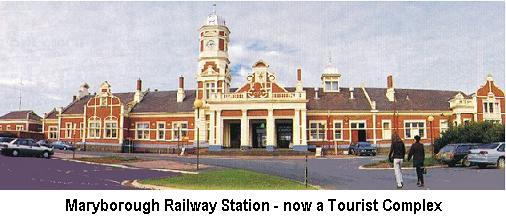 Gold was being recovered in ever increasing volumes, with large nuggets being the order of the day. In two months 3 miners wrought 1,000 oz. from near Oppossum Gully. Some areas produced 60 oz. to the ton. But on average 5 oz to the ton was the norm. At least 44 different reefs had been discovered and were worked at Maryborough. At the Main Lead the owners of one claim recovered 497 oz. from one load of wash dirt. Stories of such wealth abound from this fantastically rich area. In 1857 the total escort figures of gold from one small area was 35,409 oz of gold. This figures excludes what was sold or removed privately from the diggings. The civil authorities were continuing to display their incompetence, as at Amherst south of Maryborough the population was 6,000 with just 6 constables, while at Avoca, some 16 miles to the west with a population of just 2,000, 56 police were available. Perhaps the most infamous villain of the time was one "Gypsy Smith" A notorious bushranger whose exploits and daring robberies were well documented. It was known that he had robbed at least 14 people while under arms and kept company with a band of villains among them William Twigham, who was wanted for the shooting dead of a police sergeant at Ararat. A 400 pound reward was given for Gipsy Smith. Eventually his luck ran out and he was captured along with Twigham. Gypsy was sentenced to 15 years imprisonment with the first two years being in irons. Twigham was sentenced to death for the shooting of the police sergeant and was hanged in March 1857. The Scandinavian rush, south of Maryborough in 1858, gave incredible riches. 300 oz, from 4 buckets of wash. 70 oz. from just one bucket, and 327 oz. in another bucket. These are the recorded finds, but unrecorded finds reveal that what was officially recorded was but a small fraction of what was got from this rich ground. At about the same time a rush near Emu, 5 miles from Maryborough reapt great wealth for the 10,000 who flocked there. This rush and the inhabitants at Emu became known more their debauchery, orgies, drunkenness, fights, gambling, vice and cruelty. Local entertainment included rival whores fighting in the street bare to the waist in roped off areas. Murder and mayhem were rife and very few murderers were brought to justice in this place. At Coxtown rush one small claim produced almost 10,000 oz. of gold. It was common place to return up to 100 oz. of gold to the load. A short time later another rush occurred to Chinamans north of Maryborough and fabulous weights of gold were recovered to the load. About 15,000 joined this rush. Total gold escorts in 1857 from this area were 146,412 oz. of gold. By the end of 1857 Maryborough had begun to grow into a civilized centre, with permanent buildings being erected and a sense of continuity prevailed. Government structures let to contract included a Survey Office, Post Office, Lock up, Gaol, Court House and a Supreme Court. Private hotels numbered eleven. 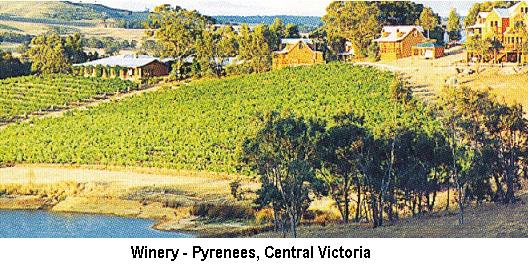 By 1864, the majority of gold in and around Maryborough had been claimed. The area had been incredibly rich and had provided great fortunes for many. Perhaps the less savoury side of life in the Maryborough goldfields was not unlike that of other fields. Perhaps the recording of such happenings was in greater detail than other places. It was an exciting place at the time. A time of great promise. A chapter in the history of Australian gold that provides an outstanding insight into the life and times of those pioneers who ventured forth to find their fortunes. Listed below are nuggets found at Maryborough over 100 oz.
|
||||||||||||||||||||||||||||||||||||||||||||||
|
||||||||||||||||||||||||||||||||||||||||||||||
|
6. THE LEGEND OF LASSETER - THE MAN Craig Wilson This begins the great saga of Harold Lasseter. His fabulous lost gold reef remains a mystery to this day. Lost somewhere in the outback of Australia this incredibly story details the story behind the legend Lasseter was indeed a charismatic character. A man whose dreams and schemes were far reaching and progressive for the times in which he lived. On closer inspection they reveal a very deep thinker and a man whose foresight was well before his time. Some may consider his schemes inappropriate, while others consider he had great forethought and his schemes entirely practical. Whatever the truth, he was entirely unconventional and there were some elements of his past that were to say the least unsavoury. Never the less they are historically factual and add to the mystery of the man. To provide the reader with some background knowledge of the man is an awesome task, but as far as can be gleaned the following is a brief summation of his life. Lasseter was born Lewis Hubert Lasseter on September 27th 1880 at Bamganie near Meredith, Victoria, Australia. He lived with his family until at the age of 9 he ran away from home. His life had been troubled even at this early age. Arrangements were made for him to live with a well to do family at Colac, Victoria not far from where he was living. Life improved until at the age of 17 he fell in with a rather unsavoury character and together they feloniously broke into a shop while armed with pistols. For this misdeed he served an 18-month sentence in a Christian reformatory. This period is important, as this is the time Lasseter was presumed to be finding his great lost gold reef in the centre of Australia. Information indicates that at the age of 21 Lasseter embarked on overseas travel, visiting England, France and possibly Belgium. He crossed the Atlantic and spent several years in the USA, where he studied agriculture, navigation and surveying. At some time in his early life he developed a good understanding of building and in particular bridge building, possibly whilst in the USA. By 1909 he had returned to Australia with a vivacious America wife, and a young child. With relatives in Adelaide, South Australia the family remained there for a few months before moving to Tabulam in northern New South Wales on the Clarence River, where he was to grow fruit and vegetables in this rich and productive area. Lasseter was a schemer and while here devised a plan to pump water from the river across a large bridge and into the town. The plan was derided by local leaders as being impracticable. Most of his schemes were to provide employment for the local population and were in fact, not without some merit. His temper at times was quick and uncontrollable and on more than one occasion he was involved in fist fights. Incredibly in 1913 he designed an arch bridge suitable for Sydney Harbour which was remarkably similar to the design that was eventually accepted, some 10 years later. At the age of 35 he enlisted in the Army in Melbourne, but was discharged a few months later as being medically unfit. A short time later he re-enlisted only to be again discharged. Although he often spoke of being at Gallipoli, records indicate that he was never there, and in fact did not serve overseas in the Great War at all. However his war service did not stop him from putting forward a method of protecting steel clad vessels from torpedoes, nor from suggesting a method of moving larger vessels through a restricted area in the Dardenelles to provide greater firepower. None of these schemes were adopted or even proceeded with. There is some indication that Lasseter may have tried to find his lost reef from Oodnadatta South Australia in 1918 without success, but this is unlikely. Throughout his life he always seemed to find at least some employment with local newspapers, and became quite an accomplished writer in this capacity. Often writing letters to the editor under assumed names his writings reflect a good command of English and of the subjects he wrote about. The marriage to his first wife, was not a particularly happy one and he eventually ceased living with this family. In 1924 he married Irene Lillywhite, and there were three children from this union. From this time he used the name Harold Bell Lasseter. It seems there may be some truth that he did not obtain a divorce before his marriage to Irene. Following this marriage the family became domiciled in Sydney and then they moved to Kogarah. A short time later he left his pregnant wife and moved to Canberra, where the national capital was being built. He worked in this area for about two years, and eventually moved with his family to Gippsland, east of Melbourne. While here he put forward a plan to build wooden ships that were so badly needed at the end of the Great War. His contributions to local papers continued throughout his life. Detailing all of Lasseter's recorded dreams and schemes would be beyond reality, but listed below are a just a few of his predictions, schemes etc. that provide an insight into his incredible character. He both predicted and warned that Japan would invade Australia. Suggested shotgun brigades to clear trenches in World War 1. Proposed the use of smoke screens to move troops forward under cover. Put forward a plan to dig a canal across the Isthmus at Bulair thus allowing battleships to enter and close on Constantinople. Was critical that Australian defence bases were situated too far south and needed to be further north to support a campaign against the Japanese, suggesting Townsville as a suitable site for a naval base. Experimented with pre-stressed concrete prior to 1920. Planned a bridge with extensive drawings suitable to cross Sydney Harbour in 1913, a full10 years before the bridge was contracted. Suggested lighting and power be placed underground rather than on poles above the ground. Put forward a plan for a HydroElectric scheme in Gippsland. Pointed out to authorities that the new National Capital had been built without a gaol. He suggested that Australia should become a republic - something that to date has not been achieved. All this from a man who died in 1931. Was he a man before his time? Being the optimist I am I prefer to believe he was. A great character, of great foresight and with a tenacious nature that has rightly led to what has become a great Australian legend. This tenacious attitude led him to resurrect his dream of rediscovering the lost gold reef, reputedly over a mile long. This brought him to the fringe of government in New South Wales in 1930 to re-ignite the passion of his golden dream among others that eventually led to the formation of the ill fated expedition. At last his dream was about to be realized.
|
||||||||||||||||||||||||||||||||||||||||||||||
|
||||||||||||||||||||||||||||||||||||||||||||||
|
||||||||||||||||||||||||||||||||||||||||||||||
|
7. A VISIT TO WEDDERBURN by Peter Brady I have always been interested in gold. For many years my business had commanded my undivided attention, except for a few brief moments when I had the opportunity to read the odd gold snippet in magazines etc. and dream of the time when I could leisurely stroll across to the Victorian gold fields, and with a new hi-tech detector find my share of nuggets in a day or two. I was well aware that Victoria with its vast gold fields was still giving up its treasure. Regurgitating gold nuggets almost on command to the new high tech metal detectors that regularly roamed across the old gold fields. To sell my business after some 10 years of hard yacker (hard work), was an easy decision. Once extracted I enjoyed the pleasure of suffering the indignity of a good long rest, where all I did was relax, and enjoy myself with travel to far flung tourist resorts for a well earned rest. My interest in the gold fields was rekindled and I considered it was about time that I travelled to Victoria to collect my share of the booty. My time was nigh. A little further 'brush up' reading on the subject would be required, and a trial run in my local gold fields with a hired detector a definite advantage. With great expectation I hired a metal detector and toddled off to the local area to try my luck. This was going to be easy. I stepped from my vehicle, hooked up the contraption and adjusted the straps to a comfortable position and with great expectation stepped forward waving the magic wand over the ground as I had been shown. I had gone about 3 feet when the machine screamed forth the high pitched sound I had been told about. The sound indicating that below the surface was gold, just waiting to be picked up. The grin on my face was so wide, my false teeth had difficulty remaining within the orifice. Discarding the detector, I used the pick provided and quickly dug a deep trench in search of this 'easy gold'. Having been instructed that one takes a handful of dirt and wave it over the detector, I carried this instruction out to the letter, and eventually ended up with a small piece in my hand that shrieked every time it was waved over the detector. I saved that bottle top. It was to be a reminder to me of my exuberant naivety for many moons to come. With the grin wiped firmly from my face, I continued my trial run for a few more hours. I found a good long piece of reef gold that turned out to be an old piece of rusting wire and more bottle tops that I am prepared to acknowledge. At least by now I was starting to grasp the nettle. I dug a lot of holes that day and was pleased that I, and I alone was the only witness to what in retrospect I reflected was damn foolish behaviour for a grown man. I may have abandoned my golden dreams then and there had I not previously booked accommodation and arranged to hire a detector in Victoria a few days hence. With what little experience I had, I ventured forth to the land where gold was sure to be there for the taking. By this time I had developed some caution and had arranged to attend an orientation and familiarization school organized by the local agent at Wedderburn. Additionally, I had arranged to go detecting the next day with a professional who accompanied novices and instructed in the finer points of metal detecting. I was now sure I was heading in the right direction. At the appointed time I arrived at the store, and was met by Barrie Johnson. An imposing figure of grand stature, with a buoyant and loud commanding voice. With a number of other 'hopefuls' we all travelled in our own vehicles to a rather stony rise just north of the town, where we alighted and formed an expectant semi circle around where a number of detectors lay on the ground. For about an hour we listened intently to what Barrie had to say. The only interruption coming from a rather impish old gentlemen who had remained seated on a small canvas chair, continually complaining that if he were to rise he would lose his under pants, as they were too loose. This broke the concentration of the group on more than one occasion and the laughter that followed broke the formality of the proceedings. Armed with this knowledge, my confidence was at an all time high, and for the remainder of the afternoon managed to wander aimlessly through the nearby bush practicing the art of metal detecting. In reality, I was attempting to differentiate bottle tops and bullets from the real thing. The next day at the arranged time my guide arrived. Michael Hamilton was younger than I had expected. Fresh faced, and with a pleasant manner that immediately made one at ease. We discussed where we would look for gold and Michael suggested that we look quite close to Wedderburn. I had imagined that we would be in a more remote place, a secret place, but this was not to be. Just south of Wedderburn some ground had been recently bulldozed so we concentrated on the edge of this newly worked ground. I was sure that this ground had been thrashed and there would be nothing here. How wrong I was. Within 15 minutes I had a sweet sound singing through my headphones. I just knew it was gold. This time I was right. Only a small piece, but never the less it was a piece of gold. The grin almost dislodged the teeth again. We spent the rest of the day wandering through the bush in ever-increasing circles, and after some hours I found another small piece, as did Michael. Late in the afternoon, we returned to where the vehicle was, pulled out the canvas chairs and sat down to rest. My attention had been directed to the ground, and I was now raising my eyes and drinking in the beauty of this place. Large eucalyptus trees reaching towards a blue sky, interspersed with a sprinkling of native bushes, gently swaying in the light breeze. A proliferation of birds winging their way through the sparse forest, and off in the distance a small wallaby cautiously feeding, occasionally casting a wary eye in our direction. I had enjoyed the day immensely, and wanted to drink in the atmosphere, clean air and fine company. What more could a man want. Perhaps a little more gold, but there would be other times, other enjoyable moments. My future direction had been firmly cemented.
|
||||||||||||||||||||||||||||||||||||||||||||||
|
||||||||||||||||||||||||||||||||||||||||||||||
8. FLECKS ! - Glints from here and there
|
||||||||||||||||||||||||||||||||||||||||||||||
|
||||||||||||||||||||||||||||||||||||||||||||||
|
9. TENNANT CREEK GOLD by Sue "Goldie" Reynolds Tennant Creek is a long way from "everywhere". Situated in central Northern Territory it is still very much a frontier town in every sense. Well, perhaps not every sense, but it is an isolated oasis and a very delightful place to visit if you have an interest in gold, as it is truly a gold town. Although Australia is a sophisticated western nation, the "outback" is still sparsely populated and under developed. The only bitumen road crossing this continent from north to south, through the centre runs from Darwin in the north to Adelaide in the South. This is the Stuart Highway, and Tennant Creek is situated about 550 miles south of Darwin and 300 miles north of Alice Springs. It is a hot place. Mid winter the temperature drops to about 85 degrees and in summer 105 degrees is not unusual. It has two seasons, one wet, one dry. Tennant Creek usually carried water and it was an ideal place to locate a repeater station for the overland telegraph linking Australia with the rest of the world. The first brick building was erected here in 1874, and remained the only brick building in this isolated location until gold was found by a linesman in 1930. With the finding of gold, came the inevitable gold rush. The last great gold rush in Australia. In 1930 this area was indeed remote. Privations abounded, roads were unmade and at times impassable for months, in the wet season. Because of its isolated location the numbers joining the rush were not huge by 1850 standards, and by 1935 only 600 people lived in the town. The area was still giving good gold, but with the advent of World War 2 in 1939, the mines closed down, as men enlisted. It was indeed a frontier. The indigenous inhabitants were still tribal and it was not unknown for spearing and clubbing of whites to occur on occasions. At the same time the white population retaliated with vigour. This was a time when Lasseter was searching for his lost gold reef, further south. The area was rich in both alluvial and deep gold, and many fortunes were made. Some diggers were remarkably lucky. Like two well-known characters, the larrikin (Ed: mischievous but likable hooligan) Jack Noble, and his mate William Weaber. Between them they only had one good eye, which Jack used well. They discovered the richest mines in the field. The Rising Sun, Kimberley Kids, Weaber's Find and Noble's Nob. 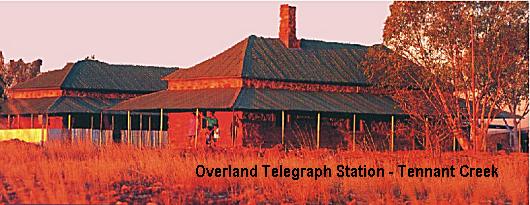 Tourism is a major industry here, and is well serviced with exceptional facilities for such a remote place. Accommodation at good quality motels and caravan parks provide well for the travelling public. Tours of the old gold mines and fields are well organized in air-conditioned vehicles, and there is an abundance of naturally occurring phenomena to be viewed and admired. Prospecting trips with detectors and panning gear and well catered for. Just a word of warning. This area is remote, and if travelling off main highways, four-wheel drive vehicles are recommended. Call at the tourist office and take some advice from the staff there. They are a friendly bunch and will gladly provide information on the area for your benefit. Today gold is still mined at Tennant Creek. Normandy Mining Limited is the largest producer of gold in the Northern Territory. Operating several gold mines in this area, total gold production from this region exceeds about 350,000 oz. per annum. Mines operate at Tennant Creek, The Granites, and Callie, in the Tanami Desert. Recent exploration has revealed substantial reserves southwest of Tennant Creek. Estimated reserves are 11 million ounces. Yes folks, there is a lot of gold left in "The Territory", and if your lucky enough, you just might find a nugget of two yourself.
|
||||||||||||||||||||||||||||||||||||||||||||||
|
||||||||||||||||||||||||||||||||||||||||||||||
|
10. BATTLE AT BALLARAT - Part 2 by Craig Wilson An intriguing story of oppression and rebellion in the Australian gold fields. Continued .... For what he found was a burgeoning colony outgrowing and forging ahead of the available infrastructure capabilities. The difficulties that were before him were immense. Britain was at war with Russia in the Crimea, and there was little finance forthcoming from London to support the burgeoning colony. Victoria was essentially left to its own devices. A grand parade was held to herald the arrival of Hotham, but although a crowd of about 10,000 lined the streets to welcome the new Governor, there were those who believed the task was well beyond just one man, no matter how experienced. Their assessment would prove to be uncannily accurate. The diggers had no right to vote and government was entirely dictatorial. When laws were made, they were made without consultation, and Hotham could not understand the wisdom of enacting a law, which provided the constable with half the fine, should a miner be without his gold license. He recognized that the abuse of such a system was obvious, but chose to continue the status quo for the time being. To see for himself the state of the diggings, and the presumed wealth of the area, a visit to various gold diggings was organised including Ballarat.
Lalor was to marry his fiancée, Alicia Dunne a refined young lady of Irish heritage herself, who was teaching at Geelong, some 50 miles south of Ballarat. Farming was in his blood and that was his intention after making a stake on the gold fields, to establish a farm. The administrators were suggesting that the gold fields unrest was directed at the Crown, where there had been some agitation for a republic, or so they thought. In reality the complaints were directed squarely at the manner in which the administration was carried out. Miners were treated with disdain, and were on many occasions treated brutally even when obtaining their monthly gold license. There had previously been trouble on the Ovens diggings in the north east of the State, and the quality of the administrators contributed substantially to the unrest. At Ballarat the diggings covered a large area, and enclaves were formed that consisted of diggers usually from similar ethnic backgrounds. The rough roads were lined with tents, which provided the much-needed supplies, from sly grog (Ed: illicit alcohol) to prostitutes, and of course the usual legal supplies. The Eureka was about 11/2 miles east of the main town along the main Melbourne Road. About halfway between the town and the Eureka was Bentley's Hotel, run by a rather unsavoury character, the reformed convict James Bentley, who happened to be a great friend with the local police magistrate, John D'Ewes, whose character was undoubtedly in question. D'Ewes was suspected of having an interest in the hotel, and on more than one occasion had protected the vicious Bentley. The visit to Ballarat by Governor Hotham and his wife was quite an occasion for the town. It was a Saturday in late August, and a huge crowd turned out and cheered to Governor into town. The diggers were ecstatic that at last their grievances were going to be heard and dealt with. The mood was to say the least entirely jovial. So jovial in fact that during the inspections that were carried out, small pieces of gold would miraculously appear from the diggings and be presented to Lady Hotham with great humility. In fact in their naivete the diggers were setting the scene for their own demise. Governor Hotham believed that with such evident wealth a license fee of a pound a month was a pittance compared to the wealth he had seen with his own eyes. When he returned to Melbourne, he was to issue a decree that would reverberate throughout the gold fields and set in motion the events that led to the eventual bloody confrontation at The Eureka Stockade. Where the licenses had been inspected at least once a month they were now to be inspected twice a week. The ignorance and arrogance of Governor Hotham was brought to the fore in devastating fashion. The die was cast, with unrest on the gold fields escalating into organized meetings, where Peter Lalor was to have such a pivotal role, in organizing and eventually leading the rebels at the Eureka Stockade.
|
||||||||||||||||||||||||||||||||||||||||||||||
|
||||||||||||||||||||||||||||||||||||||||||||||
|
11. STRIKES Recent Finds
|
||||||||||||||||||||||||||||||||||||||||||||||
|
||||||||||||||||||||||||||||||||||||||||||||||
|
12. BAROSSA GOLD by John Gladdis The Barossa Goldfield is situated about 25 miles north east of Adelaide, the capital city of South Australia. Today they are enclosed in National Parks, State Water Reserves, or on private land, and are no longer available for serious prospectors, except for a small area on State Forest Reserve. In October 1868, Job Harris, along with others found gold in Spike Gully. The gold was generally at depth, between 5 and 20 feet, and the area producing the main leads was on steep ground making accessibility difficult. Within a week 2,000 diggers were at the rush. The general features of the area reveal a rocky range running north south, which is flanked on either side by patches of tertiary deposits on the spurs. Deep gorges and creeks abound in this area, and the surrounding bush is tall with eucalyptus, and native bushes.
The rocks in this area are presumed to be from for Silurian age, from their lithological resemblance to those of Victorian goldfields. No fossils have been located so it is impossible to accurately ascertain a geological age. The rock of the area has a highly weathered appearance and contains a great deal of ironstone. Locating the gold reefs at depth was a hit and miss affair, with shafts being dug through hard conglomerate, often taking as long as four weeks, until the auriferous depths were reached, and tunnels were dug in several directions, often without success. It was backbreaking work for the 4,000 of so diggers who had rushed the site.
South Australia has never been noted for great quantities of gold, and although the Barossa gold field was a bonanza for local diggers recoveries at best at the Barossa Deep Lead were up to 9 oz. to the tub, and gradually became poorer, as the lead crossed the gully. At depth, water seeping into the shafts was a continual problem with many shafts abandoned. Gold remained elusive on the Barossa, and leads, such as Cottier's Hill, Edwards Rush, Enterprise, and Goddard's Hill all displayed promise that was short lived. At Victoria Hill, south east from Spike Gully, shafts reached 70-80 feet before good gold was got. 11 oz. to the tub was the best result. The actual gold recovered from this gold field is not well documented. Miners were reticent to disclose what they had taken and at best an estimate only can be made. Total recorded production was 12,000 oz. but a more accurate figure would be at least twice that amount. Each shaft had to be fitted with a windlass, which required a man to remain at the top of the shaft winding the bucket up and down. When a claim was pegged, a white flag was to be flown, but when gold was found, a red flag had to immediately replace the white. If this were not strictly complied with the claimant would lose his claim.
Visiting this site today, many remaining shafts and mines are well preserved. Even the toe holds diggers made to climb from these shafts are obviously evident and authorities have fenced off these areas both for safety and to preserve the site for posterity. It has become a prominent tourist destination when visiting the Barossa Valley.
|
||||||||||||||||||||||||||||||||||||||||||||||
|
||||||||||||||||||||||||||||||||||||||||||||||
|
13. A PAST OF GOLD by Leslie Cooper-Wares At 8 years of age I learnt to use a pan and work the creeks. My first experience with gold was when my father and his friend selected a mining claim to a piece of land at the base of Mount Morgan. We lived in Rockhampton, in Central Queensland. Every fortnight we woke early on the Sunday and both families would make our way inland to our claim. The four adults were quite suburban prospectors but we children of both families thrilled to the adventure and the real life treasure hunt. We fought over and were enthralled at being able to get hold of a pan and find traces of gold and small nuggets. Our enthusiasm led us up the creek finding places to dig for buckets to wash with great success. In our need to compete with each other we became quite expert at knowing appropriate places. Having to share equipment meant we often had only picks or shovels and these we used with as much competition. And each alone played the treasure seeker game of hiding our finds and sites and moved off into the hills where gold was least expected. Soon we were finding small nuggets but mainly quartz rock with ribbons of gold. All this we would return with to our site and discuss the best type of places to look. No experts to help here. No books to consult. It was all trial and error but we soon developed a sixth sense to finding the treasure that amazed our parents. When our parents were fresh they used the equipment and we went off exploring possible sites together discussing different methods of finding gold and places. One day we found a tunnel in the side of the cliff. It was a disused mine. For some reason, most likely not understood today, we were very aware of the dangers associated with our Australian wilderness. We waited outside while one of us went for the parents who allowed us into the first section of the old mine. I remember the feeling of the energy of past prospectors. At school we talked about and played games of treasure hunting and taught our friends about Fool's gold and how to find pockets of gold in ridged hills and gullies. We spoke of the first miners and their hopes and dreams. At home our shelves held phials of gold dust and small nuggets. Dad gave them away to family and friends for birthday and Christmas presents. We had chests of quartz bearing gold under the house. When we moved the boxes never reached their destination. There was no dismay as this was the time of the gold standard and it was more expensive to have the gold extracted in those days than it was worth.
|
||||||||||||||||||||||||||||||||||||||||||||||
|
||||||||||||||||||||||||||||||||||||||||||||||
|
||||||||||||||||||||||||||||||||||||||||||||||
|
||||||||||||||||||||||||||||||||||||||||||||||
|
14. THE WINGED KEEL GOLD PAN by Tony McGregor F irst seen at the Australian Gold Panning Championships in 1997, this unique pan attracted a great deal of attention, when Martin Marks, its inventor first used it at this event. Not just for its shape, but for its incredible effectiveness, and outstanding speed. The construction of the pan is indeed "different". Affectionately dubbed 'The Winged Keel Pan' by competitors and spectators alike, its ability to deal with copious quantities of wash dirt was very effectively displayed. The new pan has several unique design features and uses more than just gravity to trap the gold. The rim of the pan has a diameter of approximately 50cm (quite large!!) and the sides are quite steep with rifles around the entire circumference. It is these rifles that make the gold pan unique, for they are not parallel with the rim or the base of the pan. The rifles are angled from the top of the pan to the bottom and overlap each other. To use the pan efficiently, the operator rotates the pan in the water rather than the standard 'shaking' action of a conventional gold pan. The angle of the rifles in the pan pushes the water under the wash dirt suspending it. This allows the gold to sink to the bottom of the pan almost immediately while the lighter gravel simply washes out over the rim. It becomes easy to see why the pan processes the wash dirt so quickly. Martin confirmed the speed advantage of the pans in the Australasian Gold Panning Championships by taking out the Mens Skilled event in an incredible time of 2min 37sec. If he could repeat this time at the World Championships, he would break the current record. He also won the Veterans event in exceptional time. Another advantage of the pan is the larger size. Martin could process all of the allocated wash dirt in one load where most other competitors needed three loads. In conversation, I commented on how heavy the full pan load must be. He smiled and casually informed me that the pan has INBUILT FLOATATION. The pans come in three sizes with either a left or right hand configuration. Another interesting feature of the 'Winged Keel' pan is the 'negatively charged' material of which it is constructed. The pan is made primarily of fibreglass, with a few secret ingredients which give the pan a negative charge. This actually attracts the gold, making it stick and harder to lose specks. All metals carry a slight positive charge. Positively charged items are always attracted to a negatively charged object (e.g.. the different poles of a magnet). The efficiency of the pan, therefore, is a result of many forces working together, such as gravity, centrifugal force, electrostatic attraction, buoyancy, and water action rather than just gravity and water action in a conventional pan. He has certainly thought of everything. Martin is based at Seven Hills, New South Wales (just out of Sydney) where he designs and constructs a large variety of gold recovery equipment including concentrators, other specialized gold pans, dredges, turbo sluices, etc. Martin designed and built the legendary 'Super Sluice' which is capable of catching gold less than 20 microns. It pulverizes clay to ensure no gold is lost. The Super Sluice can be purchased as an individual item or as a complete set up with petrol motor, pump, hoses, fittings, etc. (walk out of the factory and straight to the goldfields). Martin will demonstrate his products free, and offers follow up assistance if required. For more information on the 'Winged Keel' goldpan or any of Martin's products, phone (02) 9838 0397 during business hours or (02) 9688 2851 after hours. Email Martin at [email protected]
|
||||||||||||||||||||||||||||||||||||||||||||||
|
||||||||||||||||||||||||||||||||||||||||||||||
|
15. THE NEW LODE - Next Month's Issue
|
||||||||||||||||||||||||||||||||||||||||||||||
|
||||||||||||||||||||||||||||||||||||||||||||||
 Ararat today is a city of 8000 people astride the Western Highway between Melbourne and Adelaide in the Great Dividing Range. Nearby are the beautiful Grampian Mountains, the picturesque village of Great Western, home of the world famous Great Western Champagne. Seven other wineries are just a short drive from the city.
Many beautiful old buildings still stand in the city, including the treasury, built to hold the tons of gold won from the diggings.
Ararat today is a city of 8000 people astride the Western Highway between Melbourne and Adelaide in the Great Dividing Range. Nearby are the beautiful Grampian Mountains, the picturesque village of Great Western, home of the world famous Great Western Champagne. Seven other wineries are just a short drive from the city.
Many beautiful old buildings still stand in the city, including the treasury, built to hold the tons of gold won from the diggings. 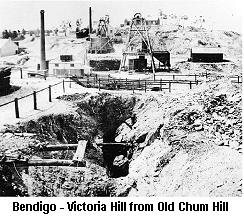 This is where men lined up for hours just to get in and buy shares in the latest rich mines and the lines often went all the way down the street and into the public bar of the Shamrock.
This is where men lined up for hours just to get in and buy shares in the latest rich mines and the lines often went all the way down the street and into the public bar of the Shamrock.
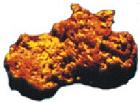
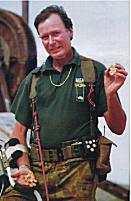
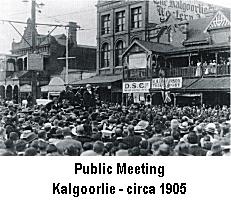 What made the Kalgoorlie gold field different from others in Australia was that from the beginning companies were present and with shareholder backing a number of quality mines were established. Initially there was great rivalry between Coolgardie and Kalgoorlie, but with ever increasing volumes of gold being wrought from the ground at Kalgoorlie, in a few short years it was no contest. Mines such as the Great Boulder, North Boulder, Boulder Central, Central and West Boulder, and Brookman Bros Boulder Company were all large operations backed by substantial financial resources.
What made the Kalgoorlie gold field different from others in Australia was that from the beginning companies were present and with shareholder backing a number of quality mines were established. Initially there was great rivalry between Coolgardie and Kalgoorlie, but with ever increasing volumes of gold being wrought from the ground at Kalgoorlie, in a few short years it was no contest. Mines such as the Great Boulder, North Boulder, Boulder Central, Central and West Boulder, and Brookman Bros Boulder Company were all large operations backed by substantial financial resources. 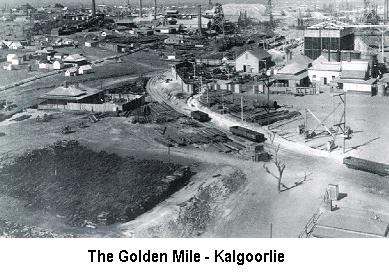 In 1939, with the advent of World War 2, large numbers of miners enlisted and with gold not being considered a required asset, production fell dramatically.
At the end of the war recovery was slow. Mining costs were rising, but not so the price of gold. However, in 1949 the British government devalued the pound lifting the price of gold by almost 50%.
The Korean War bought rampant inflation in Australia, and gains made were quickly lost. In 1954 the then Prime Minister Sir Robert Menzies introduced a gold bounty to stabilize the gold price, and stability returned once again. Coupled with improved technology, prosperity returned.
In 1939, with the advent of World War 2, large numbers of miners enlisted and with gold not being considered a required asset, production fell dramatically.
At the end of the war recovery was slow. Mining costs were rising, but not so the price of gold. However, in 1949 the British government devalued the pound lifting the price of gold by almost 50%.
The Korean War bought rampant inflation in Australia, and gains made were quickly lost. In 1954 the then Prime Minister Sir Robert Menzies introduced a gold bounty to stabilize the gold price, and stability returned once again. Coupled with improved technology, prosperity returned. 



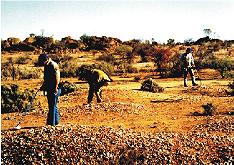
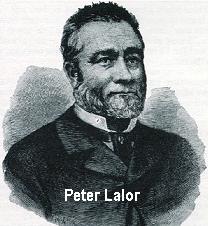 Peter Lalor was a born and bred Irishman from Queens County, he had suffered injustice and oppression and when he arrived at the Ballarat gold fields found that under British rule in Australia the situation was similar to that in his home country. A peace loving young man, he understood that negotiation rather than violence had the best chance of making the changes that the diggers sought. He was well established with his partner Timothy Hayes and had spoken at organized meetings among the diggers airing their grievances. It was not so much the actual laws, but the way they were administered by a greedy and corrupt administration that was the brunt of the digger's complaints.
Peter Lalor was a born and bred Irishman from Queens County, he had suffered injustice and oppression and when he arrived at the Ballarat gold fields found that under British rule in Australia the situation was similar to that in his home country. A peace loving young man, he understood that negotiation rather than violence had the best chance of making the changes that the diggers sought. He was well established with his partner Timothy Hayes and had spoken at organized meetings among the diggers airing their grievances. It was not so much the actual laws, but the way they were administered by a greedy and corrupt administration that was the brunt of the digger's complaints. 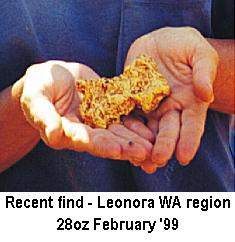
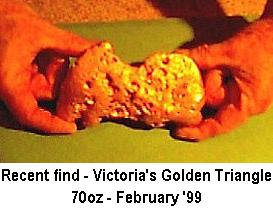
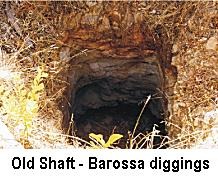 There were 3 types of gold at the Barossa. The first being quartz reef, that occurred at both the Belle of Barossa, and Menzies Barossa Mines.
Secondly, ancient alluvial deposits in drainage channels about 15 million years old and buried below a thick sequence of sand and gravel along Victoria Hill. Thirdly, modern alluvial deposits found in the present drainage channel along Walkerville Gully.
There were 3 types of gold at the Barossa. The first being quartz reef, that occurred at both the Belle of Barossa, and Menzies Barossa Mines.
Secondly, ancient alluvial deposits in drainage channels about 15 million years old and buried below a thick sequence of sand and gravel along Victoria Hill. Thirdly, modern alluvial deposits found in the present drainage channel along Walkerville Gully.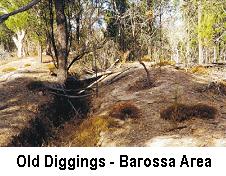 In a memo dated Jan 20th 1905, the Government Geologist stated that the deposits were appreciably auriferous at certain points only, near the junction of the cement with the bedrock, with payable gold being entrapped in layers only 2 feet thick. It was elusive, but it was there.
In a memo dated Jan 20th 1905, the Government Geologist stated that the deposits were appreciably auriferous at certain points only, near the junction of the cement with the bedrock, with payable gold being entrapped in layers only 2 feet thick. It was elusive, but it was there.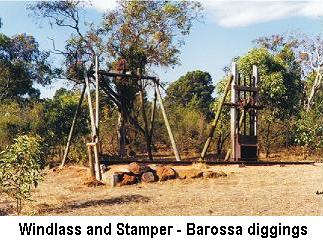 The Barossa Rush was short lived and by 1871, it was mostly abandoned, with only 100 men remaining. In the 1890's, the Menzies Mining Company established a 40-head stamper on the South Para River, but this was not a successful venture.
Surprisingly a permanent township blossomed, and remained an entity until the 1950's, when it was finally abandoned.
The Barossa Rush was short lived and by 1871, it was mostly abandoned, with only 100 men remaining. In the 1890's, the Menzies Mining Company established a 40-head stamper on the South Para River, but this was not a successful venture.
Surprisingly a permanent township blossomed, and remained an entity until the 1950's, when it was finally abandoned.
